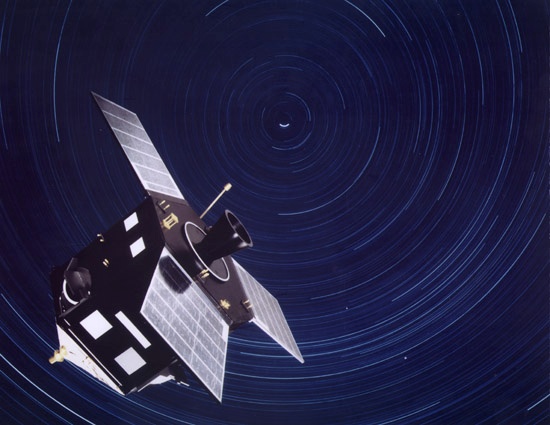Hipparcos
artificial satellite
in full High Precision Parallax Collecting Satellite
 Earth-orbiting satellite launched by the European Space Agency in 1989 that over the next four years measured the distances to more than 100,000 stars by direct triangulation using observations of parallax from either side of Earth's orbit around the Sun. It was named after the ancient Greek astronomer Hipparchus, who drew up an accurate star catalog in the 2nd century BC.
Earth-orbiting satellite launched by the European Space Agency in 1989 that over the next four years measured the distances to more than 100,000 stars by direct triangulation using observations of parallax from either side of Earth's orbit around the Sun. It was named after the ancient Greek astronomer Hipparchus, who drew up an accurate star catalog in the 2nd century BC.Hipparcos got off to a rocky start when a rocket engine failed to insert the satellite into a circular geostationary orbit, leaving the satellite in a highly elliptical orbit that passed in and out of Earth's radiation belts (Van Allen radiation belt). It was nevertheless able to operate, and the computer analysis was modified to take the noncircularity of the orbit into account.
As Hipparcos slowly rotated, a “split” Schmidt telescope continuously scanned the sky along two lines of sight 58° apart, and the manner in which the light from pairs of point sources impinged upon 2,688 very narrow parallel slits on the focal plane enabled angular separations to be precisely determined. By integrating observations, individual positions were computed to within 0.001 arc second—an improvement of 20 times over terrestrial estimates. The positions of 118,000 selected stars brighter than about 12th magnitude (roughly the observable limit for a 10-cm 【4-inch】 telescope) were thereby measured. Furthermore, observations taken years apart enabled the proper motions (proper motion) of these stars across the sky to be estimated.
About 12,000 of the sampled stars proved to have variable brightness; three-quarters of these stars had not previously been suspected of being variable. Of particular interest were the Cepheid variables (Cepheid variable), whose period of variation is longer or shorter in direct proportion to their luminosity. Cepheid variables had been used as “standard candles” to measure the distances of nearby galaxies as the first step toward measuring the scale of the universe. Hipparcos refined the basis of this distance scale (galaxy). For example, observations from Hipparcos showed that M31 (the Andromeda Galaxy), the dominant member of the Local Group, to which the Milky Way Galaxy belongs, is actually 24 percent farther away from the Milky Way than had been previously believed. The recalibration of the Cepheid period-luminosity relationship also helped to refine the value of Hubble's constant, which measures the rate at which the universe is expanding.
- Sobrāon, Battle of
- socage
- Sochi
- Social behaviour in animals
- social change
- social class
- social contract
- Social Credit Party
- social Darwinism
- social democracy
- Social Democratic and Labour Party
- Social Democratic Party
- Social Democratic Party of Germany
- Social Democratic Party of Japan
- Social Democratic Party of Switzerland
- social equilibrium
- Social Gospel
- social insect
- social insurance
- socialism
- Socialist International
- Socialist Party
- Socialist Realism
- Socialist Revolutionary Party
- socialization